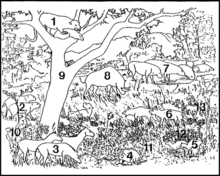Pogonodon
| Pogonodon Temporal range: Late Oligocene | |
|---|---|
 | |
 | |
| Pogonodon is labeled as #1 in this "paleobiome" illustration by Doris Tischler. | |
| Scientific classification | |
| Kingdom: | Animalia |
| Phylum: | Chordata |
| Class: | Mammalia |
| Order: | Carnivora |
| Family: | Nimravidae |
| Subfamily: | Nimravinae |
| Genus: | Pogonodon |
| Species | |
| |
Pogonodon is an extinct genus of the family Nimravidae, subfamily Nimravinae endemic to North America and Eurasia during the Eocene-Miocene epochs (30.8—7.2 mya), existing for approximately 23.6 million years.[1][2]
Taxonomy
Pogonodon was named by Cope (1880). It was synonymized subjectively with Dinictis by Adams (1896) and Macdonald (1970); it was synonymized subjectively with Nimravus by Matthew (1910). It was assigned to Nimravidae by Cope (1880), Merriam (1906), Thorpe (1920), Eaton (1922), Toohey (1959) and Bryant (1996); and to Nimravinae by Flynn and Galiano (1982), Bryant (1991) and Martin (1998).[3][4][5][6]
Morphology
A single specimen was examined by Legendre and Roth for body mass and was estimated to have a weight of 31.2 kg (69 lb).[7]
Species
P. eileenae, P. platycopis (syn. P. cismontanus, P. davisi, P. serrulidens)
References
- ↑ PaleoBiology Database: Pogonodon, basic info
- ↑ Malcolm C. McKenna, Susan K. Bell: Classification of Mammals: Above the Species Level Columbia University Press, New York 1997, 631 Seiten, ISBN 0-231-11013-8
- ↑ Full reference J. R. Macdonald. 1970. Review of the Miocene Wounded Knee faunas of southwestern South Dakota. Bulletin of the Los Angeles County Museum of Natural History, Science 8:165-82
- ↑ Full reference M. R. Thorpe. 1920. American Journal of Science 200
- ↑ L. Toohey. 1959. The species of Nimravus (Carnivora, Felidae). Bulletin of the American Museum of Natural History 118
- ↑ J. J. Flynn and H. Galiano. 1982. Phylogeny of early Tertiary Carnivora, with a description of a new species of Protictis from the middle Eocene of northwestern Wyoming. American Museum Novitates 2725
- ↑ S. Legendre and C. Roth. 1988. Correlation of carnassial tooth size and body weight in recent carnivores (Mammalia). Historical Biology